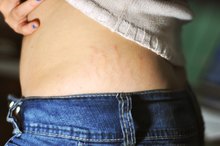What does fact checked mean?
At Healthfully, we strive to deliver objective content that is accurate and up-to-date. Our team periodically reviews articles in order to ensure content quality. The sources cited below consist of evidence from peer-reviewed journals, prominent medical organizations, academic associations, and government data.
The information contained on this site is for informational purposes only, and should not be used as a substitute for the advice of a professional health care provider. Please check with the appropriate physician regarding health questions and concerns. Although we strive to deliver accurate and up-to-date information, no guarantee to that effect is made.
How to Use Hair Removal Cream on Tattoos
After getting a tattoo on one of your body parts, such as your chest, that requires you to remove thick hair to make the tattoo visible, you may consider using a hair removal cream. Also called depilatories, these creams are safe to use on your tattoos, if you follow the manufacturer's instructions. The chemicals in a hair removal cream dissolve the hair on the epidermis, according to the U.S. Food and Drug Administration 1. A healed tattoo resides below your epidermis--in the dermis. Therefore, it's not affected by a depilatory.
Wait to remove your hair until your tattoo is completely healed, which typically takes approximately two weeks. A healed tattoo will be rid of scabs, redness, swelling, and shiny, pink skin. If you're not sure, ask your tattoo artist if your tattoo is healed.
Treatment of Irritation From Hair Removal
Learn More
Perform a patch test with your depilatory. Squeeze a dime size amount of the cream onto a cotton swab. Apply the cream to an edge of your tattoo outline. Choose a spot that is hidden if possible, such as the inside of your arm, if you have a sleeve tattoo.
Leave the cream on your skin for the amount of time specified by the manufacturer. Rinse the cream off with cold water. Examine the skin and your tattoo where the cream removed the hair, looking for blisters or burnt skin. Wait 24 hours to ensure that an allergic reaction to the cream does not occur.
Can I Repair Chemically Treated Hair Loss?
Learn More
Apply the removal cream to the hair covering your tattoo in sections with a cotton swab. Start on the left side of the tattoo and move toward the right. Cover the hair on and around your tattoo completely with the hair removal cream.
Wash your hands immediately after applying the cream. Set a timer for the recommended amount of time, making sure not to touch the cream while you wait.
Dampen a tissue with cool water after the timer goes off. Apply the tissue to your skin, removing the hair removal cream by pushing against the pattern of your hair growth. Wipe the cream off your tattoo until the cream is no longer visible.
Rinse your skin with cool water. Moisturize your skin with a fragrance-free lotion to avoid irritation.
Tips
Trim down long hair with clippers or scissors before using the hair removal cream.
Wear a pair of latex gloves to protect your hands while using the hair removal cream.
Warnings
Never use hair removal creams near or in your eyes, nose, mouth or genitals.
Never apply hair removal cream more than twice to the same area within 48 hours.
Related Articles
References
- U.S. Food and Drug Administration: Removing Hair Safely
- Warshaw EM, Schlarbaum JP, Taylor JS, et al. Allergic reactions to tattoos: Retrospective analysis of North American Contact Dermatitis Group data, 2001-2016. J Am Acad Dermatol. 2019;2:e61-e62. doi:10.1016/j.jaad.2019.09.077
- Kaur RR, Kirby W, Maibach H. Cutaneous allergic reactions to tattoo ink. J Cosmet Dermatol. 2009;8:295-300. doi:10.1111/j.1473-2165.2009.00469.x
- Lynn C, Michaela, Herdrich D, et al. The evolutionary adaptation of body art: Tattoo as an honest signal of enhanced immune response in American Samoa. Amer J Hum Biol. 2019:e23347. doi:10.1002/ajhb.23347
- Wilson WT, O’Boyle M, Leach WJ. Unusual complication of a tattoo in an immunosuppressed patient. Case Reports 2018; 2018:bcr-2018-224968. doi:10.1136/bcr-2018-224968
- Oanţă A, Irimie M. Tinea on a tattoo. Acta Dermatovenerol Croat. 2016;24(3):223-4.
- Tohme RA, Holmberg SD. Transmission of hepatitis C virus infection through tattooing and piercing: a critical review. Clin Infect Dis. 2012;54:1167–1178. doi:10.1093/cid/cir991
- Centers for Disease Control and Prevention. HIV transmission. Updated August 6, 2019.
- Warshaw EM, Schlarbaum JP, Taylor JS, et al. Allergic reactions to tattoos: Retrospective analysis of North American Contact Dermatitis Group data, 2001-2016. J Am Acad Dermatol. 2019;2:e61-e62. doi:10.1016/j.jaad.2019.09.077
- Kirby W, Alston DB, Chen AH. The incidence of hypertrophic scarring and keloid formation following laser tattoo removal with a quality-switched Nd:YAG laser. J Clin Aesthet Dermatol. 2016;9(5):43–47.
- Islam PS, Chang C, Selmi C, et al. Medical complications of tattoos: A comprehensive review. Clin Rev Allergy Immunol. 2016;50(2):273-86. doi:10.1007/s12016-016-8532-0
- Valbuena MC, Franco VE, Sánchez L, Jiménez HD. Sarcoidal granulomatous reaction due to tattoos: report of two cases. An Bras Dermatol. 2017;92(5 Suppl 1):138–141. doi:10.1590/abd1806-4841.20175860
- Orzan OA, Popa LG, Vexler ES, Olaru I, Voiculescu VM, Bumbăcea RS. Tattoo-induced psoriasis. J Med Life. 2014;7 Spec No. 2(Spec Iss 2):65–68.
- Ross JR, Matava MJ. Tattoo-induced skin "burn" during magnetic resonance imaging in a professional football player: a case report. Sports Health. 2011;3(5):431–434. doi:10.1177/1941738111411698
- Kaur RR, Kirby W, Maibach H. Cutaneous allergic reactions to tattoo ink. J Cosmet Dermatol. 2009;8:295-300. doi:10.1111/j.1473-2165.2009.00469.x
- Brady BG, Gold H, Leger EA, Leger MC. Self-reported adverse tattoo reactions: a New York City Central Park study. Contact Dermatitis. 2015 Aug;73:91-99. doi:10.1111/cod.12425
- Forbat E, Al-Niaimi F. Patterns of reactions to red pigment tattoo and treatment methods. Dermatol Ther (Heidelb). 2016;6(1):13–23. doi:10.1007/s13555-016-0104-y
- Rosenbaum BE, Milam EC, Seo L, Leger MC. Skin care in the tattoo parlor: A survey of tattoo artists in New York City. Dermatology. 2016;232:484-489. doi:10.1159/000446345
- Khunger N, Molpariya A, Khunger A. Complications of tattoos and tattoo removal: Stop and think before you ink. J Cutan Aesthet Surg. 2015;8:30–36. doi:10.4103/0974-2077.155072
- United States Food and Drug Administration. Tattoos & permanent makeup; fact sheet. Oct 31, 2019.
Writer Bio
Maude Coffey retired after 10 years working as a professional body modification artist in the tattoo industry. She is certified in principles of infection control and blood-borne pathogens. Coffey received additional training and classes, such as anatomy, jewelry standards and aftercare, from the Association of Professional Piercers. Coffey aims to educate about safe tattooing and piercing practices while writing for various websites.








